Coat of arms of Moravia
The coat of arms of Moravia has been used for centuries representing Moravia, a traditional province in present-day Czech Republic. The coat of arms of Moravia is also present in one of the fields in the greater coat of arms of the Czech Republic.
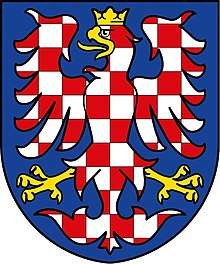
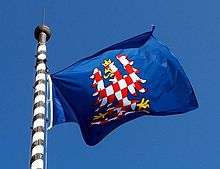
The coat of arms of Moravia is charged with a crowned white-red chequered eagle with golden claws and tongue. The eagle, that appeared in the seal of Margrave Přemysl (1209 - 16 October 1239), a younger son of King Ottokar I of Bohemia, according to Karel Maráz could be imperial, surely it's not Moravian eagle, but very probably it's flaming eagle (according to his father Ottokar I of Bohemia). The first type of the seal of Margrave Přemysl is documented only in a single copy and can not be said much about the worn seal image. The shape, however, was a gable seal, filling of the sealing field is a lion. Margrave Přemysl (+1239) originally seal with a lion (as before Margrave Vladislav Jindřich), but the number of tails is still uncertain. Two are visible only on the seal of the margrave and the younger king Ottokar I of Bohemia (1247). On the second type of Margrave Přemysl, used in the years 1233–1239, it is already a typical equestrian one-sided painting for the Moravian margraves. However, the rider now does not carry a lion on the shield, but carries an eagle. However, it cannot yet be a Moravian eagle; it is an eagle as a symbol of independence from the bohemian king in Prague. The choice of the seal equestrian image and the eagle instead of the traditional lion is evidently an expression of the resistance of the margrave Přemysl towards his older brother and King of Bohemia Wenceslas I, in which Přemysl stayed at that time.[1][2][3][4]
From 1272 onwards, the coat of arms of Moravia was also displayed in the town seal of Znojmo, bearing a 'Z' as escutcheon. In 1758, the citizens of Olomouc were granted the Moravian coat of arms by Maria Theresa in thanks for their defence against Prussian troops under King Frederick the Great during the Seven Years' War, then with the initials 'F' (for Emperor Francis I), 'M' and 'T' (for Maria Theresa).
From 1915 to 1918 the Moravian Eagle was chequered in red and gold instead of the traditional red and silver, but this was never popular among the Moravians.
Moravian eagle
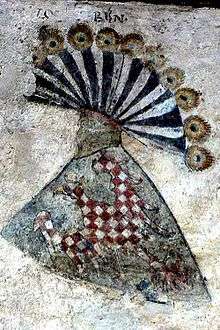
The Moravian eagle in its current form was created in the middle of the 13th century by Ottokar II of Bohemia. This Moravian margrave has become the King of Bohemia and in addition to the Bohemian silver lion (originally Moravian) in the red field, he has (recently) started to use the silver red chequered Moravian eagle in the blue field.[5][6] The silver-red chequered eagle with the gold crown and gold armor (i.e. beak, tongue and claws) on a blue shield is at this time and later captured by works of art and official documents.[7][8]
The oldest color representations of the Moravian eagle
The oldest color representation of the Moravian eagle can be found in the hall of the town castle (palace) of Gozzoburg in Krems, because Ottokar II of Bohemia reigned over the Austrian countries.[9] At the latest since the Luxembourg era, the silver-red chequered eagle was considered as the coat of arms of the Moravian country.[10] According to some researchers, these colors were derived from the colors of the Bohemian lion (a silver lion on a red shield) and expressed the link of Moravia with the King of Bohemia and the Czech monarchy.[11]
Origin of the chessboard of Moravian eagle
The Moravian eagle is distinguished from many other heraldic eagles by its distinctive chessboard (aquila scacata) or, according to heraldic terminology, sometimes also by chequer (aquila tesserata). The eagle's chessboard is documented on the oldest known seal for the city of Znojmo since September 1, 1272. These are the coat of arms of the lord of the city, of the king Ottokar II of Bohemia (since 1247 Moravian margrave). In the Baroque artistic conception, chess is conceived as a routing. Many researchers have already tried to explain the origin of eagle's chessboard.[12]
Other old color representations of the Moravian eagle
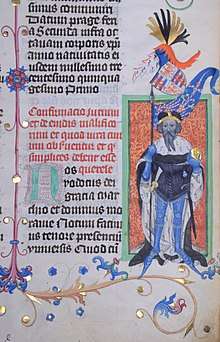
The gallery of Charles IV's coat of arms dates back to 1361, at the castle of Lauf near Nuremberg, built by the emperor Charles IV. in 1356 on the Reich road between Prague and Nuremberg on the ruins of an old Stauf castle. In its coat of arms, there are coat of arms from Moravia and Bohemia, other countries, clergy, nobles and cities in the coat of arms gallery.[13][14][15] The mural of the Moravian eagle is also in the back of the entrance to the room on the first floor of the large tower of Karlštejn Castle.[16]
Jihlava Legal Book
Many representations of the Moravian eagle represent illuminations in the legal book of Jihlava (Gelnhausen Codex) of the beginning of the 15th century (1407), written by a lawyer Jan de Gelnhausen in less than ten years.[17]
The Moravian eagle is used here in the heraldic decoration of the text, on the shields, the horse trappings, but also on the banners carried by the Moravian margraves and the kings of Bohemia from the 13th to the 15th centuries, represented in each city privilege issued by them: Moravian margrave from 1228 to 1239 Přemysl, King of Bohemia from 1230 to 1253 Wenceslas I, Moravian margrave from 1247 to 1278 and King of Bohemia from 1253 to 1278 Přemysl Otakar II, Moravian margrave from 1333 to 1349 Charles I, king of Bohemia from 1346 to 1378 and Roman emperor from 1355 to 1378 Charles IV, Moravian margrave from 1349 to 1375 John Henry, Moravian margrave from 1375 to 1411 and Roman king from 1410 to 1411 Jošt of Luxembourg, also known as Moravian. He appears here alone and with the Bohemian lion.[18]
The oldest written mention of the Moravian eagle
The oldest written mention of the Moravian eagle can be found in the versed chronicle of Ottokar Styria, which describes the events that took place in central Europe from the middle of the 13th century to the end of the first decade of the 14th century.
During the battle of Kressenbrunn on July 12, 1260, in which the troops of the Bohemian king and the Moravian margrave Ottokar II of Bohemia conquered the troops of the Hungarian king Bela IV, is next to the Bohemian banner (white lion in the red field): „in einem rȏten samît ... ein lewe wîz" describes the banner of Moravia (white-red chequered eagle): „ein geschâchzabelten arn von rȏter und von wîzer varbe“.[19][20][21] Chronicle of Ottokar Styria, verse 7259-7268: "Hern Dietrich Spatzmanen / sach man die banier leiten: / in einem rȏten samît breiten / was gewohrt ein lewe wîz. / ouch heten ir baniere flîz, / die von Merhaeren wârn: / ein geschâchzabelten arn / von rȏter und von wîzer varbe / sach man ob in begarbe / waejen von dem winde.".
The coat of arms of Emperor Frederick III. Habsburg
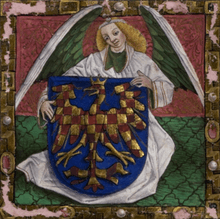
Armorial charter (sign privilege) of the Roman emperor Frederick III. published December 7, 1462 on the initiative of the governor of the province of Moravia and marshal of the Kingdom of Bohemia, Henri de Lipá, changed the original silver dye of the Moravian eagle by changing the chess fields from silver to gold, thus creating the new corporate coat of arms („color albus in glaucum sive aureum transmutetur“ (white colour changed to yellow or gold)).[22][23][24][25]
Its issuing is an example of international influences in the difficult moments of the reign of king George of Poděbrady and of interference in the internal affairs of the Bohemian Crown since Frederick III. Habsburg granted it to the Moravian domains as a Roman emperor. Moravia, however, was part of the Bohemian Crown and, according to the emperor and King Charles IV. issued laws to take such action, the Roman monarch had no authority, because Moravia was under the direct rule of the King of Bohemia.[26]

This imperial privilege was not confirmed by George of Poděbrady and did not correspond to normal use. The Charter was valid because it had all the legal requirements but was not effective.[27] In 1628, the charter appeared in the list of privileges, which should not contradict the newly issued provincial system, and was thus, as well as many other older "harmless" privileges then confirmed purely formally approved by Ferdinand II, without explicitly addressing.[28] The privilege of Frederick, however, before or after 1628 had no effect on the Moravian coat of arms, as evidenced by the parliamentary articles published until 1838, the provincial orders of 1545, 1562, 1604 and 1628.[29][30]
This is confirmed, for example, by the imperial copy of the manuscript of Müller's map of Moravia from 1714–1716, which was dedicated to the emperor Charles VI.[31][32]
The fact that the silver-red chequered eagle in the blue shield is a sign of the Margraviate of Moravia is also officially confirmed by the imperial decrees of the second half of the 18th century and the first half of the 19th century.[33] If the change in the color of the Moravian eagle by a document of Frederick III. from the beginning was understood as a change of the national emblem, then all these imperial decrees would be acts abolishing the provisions of this coat of arms.[27]
The coat of arms described in Frederick's privilege was later, at the end of the 18th century, but especially from the first half of the 19th century, called the coat of arms of Moravia (some authors, politicians, parties, officials ...). As far as Bohemia is concerned, it has been applied not as a strengthening and unifying element of the state, like the colors of the Bohemian lion and the Moravian eagle since the middle of the 13th century, but as an attempt to disturb it. This situation escalated especially after 1848, when the double coloring of the symbols used by Moravians and the regional authorities caused disputes. The Charter is thus not an example of the development of mutual statehood, but rather an external power interference with centrifugal tendencies.[34]
19th century

The fact that the Moravian coat of arms occurred thanks to the armorial charter of December 7, 1462 in two forms in Moravia became a problem only in the 19th century. The centuries-old and officially valid coat of arms was the silver-red chess eagle with a golden crown and armor in the blue shield. The charter of December 7, 1462, although not enforced in practice, later especially since the middle of the 19th century allowed the use of red and gold chequered eagle by provincial authorities. As of the end of the 18th century the representatives of the Moravian provincial administration began to get into some awareness of the charter, especially from the thirties and since the forties of 19th century. This led to increasingly striving for the recognition of that coat of arms by the Emperor. But he did not recognize it until 1915. Yet some of the statements of the Vienna authorities have said that the use of red and gold chequered eagle is not hindered. Throughout the 19th century, the question was whether a valid but officially ineffective coat of arms of Frederick III. Habsburg has priority before the historically used and confirmed coat of arms of Moravia.[35]
20th century
Until 1915, the silver and red chequered eagle was used in the large and medium coat of arms of Austria-Hungary. In 1915, the chess of an eagle representing the coat of arms of Moravia in the middle coat of arms was changed from red silver to red gold, when in October 1915 a change to the national coat of arms Austro-Hungarian was publicly announced.[36][37]
Thus, only in 1915, the coat of arms was created for Austria (previously an unofficial term for "Kingdom and land represented in the Imperial Council of Vienna"), now a name emphasizing the importance of central government, in which the coat of arms of Moravia were introduced chess eagle in red gold (at that time, in the kingdoms and countries of the Imperial Council of Vienna represented, used the coat of arms for the whole of Austria-Hungary, and in Hungary (Lands of the Crown of Saint Stephen) used the Hungarian coat of arms.[38][39][40][41] These coats of arms were then used in the years 1915–1918.
Czechoslovak Republic
After the creation of Czechoslovakia, the coat of arms of Moravia, which became part of the state coat of arms of the Czechoslovak Republic, returned to silver. Since 1918, the chequered eagle in the coat of arms of Moravia is again binding silvery red. This fact was confirmed by Constitutional law 252/1920 Sb. of the Czechoslovak Republic, 30 March 1920, and in recent times, when the Czech Republic was created, Law 3/1993 (state book of laws), within the meaning of the Constitution of the Czech Republic, which clearly states Bohemia, Moravia and Silesia.[42][43][44][45]
 Middle coat of arms of Czechoslovakia (1920–1939)
Middle coat of arms of Czechoslovakia (1920–1939)
Czech republic
The coat of arms of Moravia is now part of the great national coat of arms of the Czech Republic, described in the State Symbols Act of the Czech Republic: "Quarterly, first and fourth gules a lion rampant double-queued argent crowned, armed and langued or (for Bohemia), second quarter azure an eagle displayed chequy gules and argent crowned, armed and langued or (for Moravia), third quarter or, an eagle displayed sable crowned of the first, armed and langued gules, on its breast a crescent trefoiled and a crosslet argent (for Silesia)."[46]
.svg.png) Coat of arms of the Czech Republic (1990–1992)
Coat of arms of the Czech Republic (1990–1992)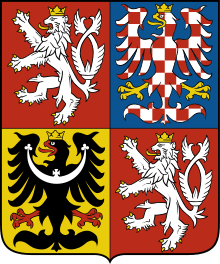 Greater coat of arms of the Czech Republic from 1992 by Jiří Louda
Greater coat of arms of the Czech Republic from 1992 by Jiří Louda
21st century
Coat of arms of the regions
After their creation, the new regions obtained the right to ask the Chamber of Deputies of the Parliament of the Czech Republic for a coat of arms and a flag. The Subcommittee on Heraldry and Vexillology of the Chamber of Deputies has recommended to the regions to take into account in their coat of arms (and flags) their historic affiliation to the countries of origin. The regions of Bohemia were recommended by the Bohemian lion, the Moravian-Silesian region, the Silesian eagle, the Moravian regions and regions of which part belongs to Moravia, the Moravian eagle. The Moravian eagle in these coat of arms is considered a silvery red chequered eagle, which is based on the coat of arms of the Kingdom of Bohemia and the coat of arms of the Austro-Hungarian monarchy.[47]
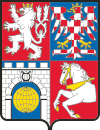 Coat of arms of Pardubice Region.
Coat of arms of Pardubice Region.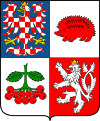 Coat of arms of Vysočina Region.
Coat of arms of Vysočina Region.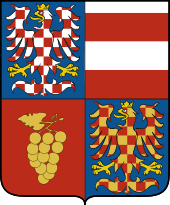 Coat of arms of South Moravian Region.
Coat of arms of South Moravian Region.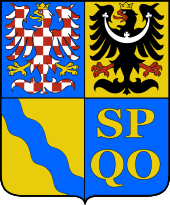 Coat of arms of Olomouc Region.
Coat of arms of Olomouc Region.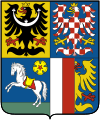 Coat of arms of Moravian-Silesian Region.
Coat of arms of Moravian-Silesian Region.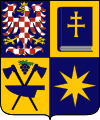 Coat of arms of Zlín Region.
Coat of arms of Zlín Region.
Coat of arms of the South Moravian Region
The coat of arms of the South Moravian Region has two eagles. In the first field of the quartered shield there is a Moravian eagle and in the fourth field a gold-red chess crowned eagle with gold armor. This corresponds to the flag of the region, which is Moravian eagle in the upper pole blue field of the quartered leaf and in the lower fluttering blue field yellow-red chequered crowned eagle with yellow armor.[48][49]
The Bohemian lion, Silesian eagle and Moravian eagle are unique heraldic and vexillological figures. They do not need to be described in any further detail.[26]
See also
References
- Prinz, Friedrich (1993). Deutsche Geschichte in Osten Europas: Böhmen und Mähren. Berlin: Wolf Jobst Siedler Verlag GmbH. p. 381. ISBN 3-88680-200-0. Retrieved 25 February 2013.
- Maráz, Karel (2014). Sfragistika: studijní texty pro posluchače pomocných věd historických a archivnictví: Panovnická a státní sfragistika. Brno: Masarykova univerzita. pp. 72, 78, . ISBN 978-80-210-7143-8.CS1 maint: extra punctuation (link)
- "Karel Maráz, Sfragistika: studijní texty pro posluchače pomocných věd historických a archivnictví: Panovnická a státní sfragistika, Brno, 2014, s. 70-95" (PDF). Retrieved 2020-02-13.
- Valecký, Štěpán (2017). Erb českých králů. Zobrazování českého znaku v době Přemyslovců a Lucemburků (in Czech). Praha: Univerzita Karlova v Praze, Katolická teologická fakulta. pp. 30, 37, 39–40, 41.
- Pícha, František (2011). "O klenotu znaku moravského markraběte" (in Czech). 15 (30). Brno. pp. 7–32.
- Vojtíšek, Václav (1921). Naše státní znaky (staré a nynější) (in Czech). Praha: Vesmír. p. 21.
- Růžek, Vladimír (2013). "Cesty k definici (nejen) moravského znaku a praporu" (in Czech) (10). pp. 20–22:22. ISSN 1213-6581. Retrieved 2018-12-11.
- Svoboda, Zbyšek; Fojtík, Pavel; Exner, Petr; Martykán, Jaroslav (2013). "Odborné vexilologické stanovisko k moravské vlajce" (169). Praha. pp. 3319, 3320.
- Krejčík, Tomáš; Pícha, František (2009). "Český a moravský znak ve znakové galerii v Gozzoburgu v Kremsu" (in Czech). 13 (28). Brno. pp. 49–57. ISSN 0862-8963.
- Adamová, Karolina (1982). "K heraldické výzdobě Staroměstské mostecké věže. Právně historický pohled" (in Czech). 15. Praha: Panorama. pp. 44–62. ISSN 0555-0238.
- Růžek, Vladimír (2013). "Cesty k definici (nejen) moravského znaku a praporu" (in Czech) (10). pp. 20–22:21. ISSN 1213-6581. Retrieved 2018-12-11.
- Bílý, Jiří (2006). Moravská orlice, symbol panovníka, země a národa (in Czech). Brno: Moravský národní kongres. p. 277.
- Růžek, Vladimír (1988). "Česká znaková galerie na hradě Laufu u Norimberka z roku 1361" (in Czech). 38 (1). pp. 37–311.
- Bobková, Lenka (2004). "Hrady Karla IV. v Laufu a Tangermünde, Panovnická reprezentace vepsaná do kamene" (in Czech). Praha.
- "Česká znaková galerie na hradě Laufu u Norimberka z roku 1361". Retrieved 2018-12-11.
- "Malba moravské orlice ve velké věži hradu Karlštejn v Čechách". Retrieved 2018-12-11.
- "Jihlavský archiv ukázal své nejvzácnější dokumenty, jinak nepřístupné". 2012-11-03. Retrieved 2019-04-21.
- "Gelnhausenův kodex (kodex A) - právní kniha. Jošt Lucemburský s moravským praporem v Jihlavské právní knize z roku 1407 na foliu 63r". Retrieved 2018-12-11.
- "Ottokars Österreichische Reimchronik (MGH Deutsche Chroniken V,1)". Retrieved 2018-12-11.
- "Ottokar von Steiermark: 'Steirische Reimchronik'". www.handschriftencensus.de. Retrieved 2018-12-11.
- František, Pícha (2013). "Znaky a prapory v kronice Ottokara Štýrského" (in Czech and English) (169). Praha. pp. 3320–3323.
- Vojtíšek, Václav (1921). Naše státní znaky (staré a nynější) (in Czech). Praha: Vesmír. p. 22.
- Habrich, Alexius, ed. (1781). "Iura primaeva Moraviae" (in Latin). Brno. pp. 38–42.
- Kalousek, Josef, ed. (1890). "Archiv český čili staré písemné památky české i moravské, svazek X" (in Latin). Praha. pp. 273–274.
- Bretholz, Berthold (1908). Das mährische Landesarchiv, Seine Geschichte, seine Bestände (in German and Latin). Brno. p. 124.
- Štarha, Ivan. "Historie, moravské barvy a moravská vlajka" (in Czech). 2013 (9). pp. 8–9. ISSN 1213-6581. Retrieved 2018-12-11.
- Pícha, František (2013). "K 550 letům erbovní listiny císaře Fridricha III. pro moravské stavy" (in Czech). 17 (32). Brno. pp. 60–80. ISSN 0862-8963.
- Štarha, Ivan. "Historie, moravské barvy a moravská vlajka" (in Czech). 2013 (9). pp. 8–9:8. ISSN 1213-6581. Retrieved 2018-12-11.
- Naše znaky státní (staré a nynější), s. 23.
- Sedláček, Pavel (2009). Symboly republiky (PDF) (in Czech). Praha: Vláda České republiky. p. 10.
- "Císařský exemplář Müllerovy mapy Moravy". Retrieved 2018-12-11.
- Paldus, Joseph (1907). Johann Christoph Müller. Ein Beitrag zur Geschichte vaterländischer Kartographie, in: Mitteilungen des K. u. K. Kriegsarchivs, 3. Folge, 5. Band (in German). Vídeň. pp. 79–82.
- Hlinomaz, Milan (1995). "Ke státní a zemské symbolice českého státu v období 1526–1918" (PDF) (in Czech) (3). p. 161. ISSN 1211-9768. Retrieved 2018-12-11.
- Mlateček, Karel; Černušák, Tomáš (2018). Morava jako součást českého státu. Společný vývoj od středověku do 20. století. Události – jevy – osobnosti (in Czech). Brno. pp. 130, 132.
- Pícha, František (2018). "Moravské barvy a vlajky v revolučním roce 1848" (in Czech). 22 (37). Brno. pp. 40–41.
- "11. října 1915, Brno - nařízení tiskové policie ve věci vydání nového státního znaku". Retrieved 2020-02-10.
- "Das Wappen und die Landesfarben Mährens" (in German) (233). 1915. p. 1. Retrieved 2020-02-10.
- "Vyhláška c. k. ministerského předsedy ze dne 3. listopadu 1915, kterou se stanoví a popisuje znak rakouských zemí". Retrieved 2018-12-11.
- "Kundmachung des k. k. Minister-präsidenten vom 3. November 1915, betreffend die Festsetzung und Beschreibung des Wappens der österreichischen Länder". Retrieved 2018-12-11.
- "Moravské zemské barvy v roce 1915 - otázka vyvěšování praporů, uveřejnění schválených nových znaků rakousko-uherského mocnářství a rakouských zemí v říšském zákoníku". Retrieved 2018-12-11.
- "29. prosince 1915, Brno - stanovení znaku rakouských zemí a znaku rakousko-uherské monarchie a způsobu jejich užití". Retrieved 2018-12-11.
- "Zákon ze dne 30. března 1920, kterým se vydávají ustanovení o státní vlajce, státních znacích a státní pečeti". Retrieved 2018-12-11.
- "Nařízení ze dne 20. srpna 1920 k provedení zákona ze dne 30. března 1920, č. 252 Sb. z. a n., kterým se vydávají ustanovení o státní vlajce, státních znacích a státní pečeti". Retrieved 2018-12-11.
- "Zákon ze dne 21. října 1936 o užívání vlajek, znaků a jiných symbolů, jakož i stejnokrojů a odznaků, a o opatřeních proti závadným označením". Retrieved 2018-12-11.
- "Moravská orlice jako součást státních symbolů Československé republiky (1918-1939, 1945-1960), Protektorátu Čechy a Morava (1939-1945), České republiky (1993-)". Retrieved 2018-12-11.
- "Moravská orlice ve velkém státním znaku". Retrieved 2018-12-11.
- Karpíšková, Lucie (2008). "Proces tvorby krajských znaků" (PDF) (in Czech). pp. 24–97. Retrieved 2020-02-10.
- "Interní normativní akt volených orgánů kraje. Směrnice: Znak, vlajka a logo JMK. Zásady pro použití znaku, vlajky a loga Jihomoravského kraje". Retrieved 2020-02-14.
- Karpíšková, Lucie (2008). "Proces tvorby krajských znaků" (PDF) (in Czech). pp. 24–30. Retrieved 2020-02-14.
External links
- Wikipedia, Czech article: (Moravian eagle)
- Heraldická terminologická konvence - Orlice: Národní orlice: Orlice moravská (Czech)